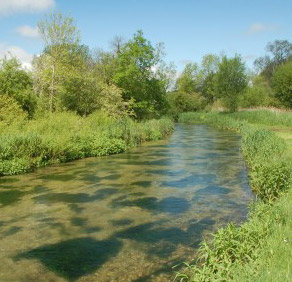The River Lambourn is a Site of Special Scientific Interest (SSSI) and a Special Area of Conservation (SAC).

The Lambourn is a classic chalk stream, rising above the village of Lambourn and flowing south east, under the M4 by Welford and through Newbury before joining the river Kennet.
The waterbody status of the Lambourn is currently (2019) moderate, with issues related to land and transport drainage, North American Signal crayfish, rural land management and barriers created by ecological discontinuity. While the physiochemical quality of the river has increased since 2016 due to improved dissolved oxygen and phosphate levels, fish and plant populations are only of moderate quality and the presence of Polybrominated diphenyl ethers (PBDE) led the river to fail its chemical assessment.
Actions complete:
- ARK’s Love the Lambourn phase 1 was completed in 2021 and phase 2 was completed in 2022. To read more about the project, click here to view our project page.
- The Newbury Renewal Group have been working with the Environment Agency and Action for the River Kennet to restore habitat through the urban river in Newbury.
- Upstream of Eastbury to Great Shefford: some channel enhancement works have been carried out. Through stewardship schemes grazing intensity and access to the river is being limited.
- Great Shefford to M4: enhancement work has been carried out at Welford Park and upstream of Weston Mill. Fish passage has been secured at Welford Gauging Weir and Weston Mill. Between Welford Park and the M4 a restoration project was carried out (1996/97) and habitat is currently very good along most of this restored reach, although localised enhancements are to be encouraged.
- M4 to Boxford: an enhancement scheme at Westbrook has been completed.
- Boxford to Watermill Theatre: physical habitat restoration for over 2 km was carried out on Hunts Green Estate (see photo above) and a major set of structures at Woodspeen Mill were taken out. This removed a significant impoundment and blockage to fish movement and the morphological condition of the channel is now significantly improved.
- Watermill Theatre to Shaw Mill: a technical fish pass at Bagnor, just downstream from Bagnor Bridge, was installed in 2016/17 to overcome a significant barrier to fish passage. A weir was removed at Donnington Grove Golf Course and habitat was restored for 350 m in 2007/8. A project to remove Shaw Gauging Station was completed in December 2019; the crump weir has been completely taken out, removing the impounding effect it had on the river and restoring fish migration, and the banks either side have also been re-profiled. Below Shaw Gauging Station 700 m of in-channel restoration was completed in 2009/10. At Shaw Mill a fish pass was created around the mill, including 100 m of naturalised channel in 2013/14.
- Winterbourne Stream: Hunts Green Estate have recently carried out some tree canopy works and habitat enhancements which have had a positive impact on the watercourse. Enhancement works have been carried out upstream of the village.
Actions required:
- The Lambourn receives road runoff from the M4. In 2015 Action for the River Kennet took sediment samples from the river bed which showed the presence of heavy metals and other toxins. In 2019 the Environment Agency installed water quality measuring sonds which demonstrated that during rain events turbidity downstream from the M4 discharge was 200 times greater than upstream. The Catchment Partnership are talking to Highways England to find a better way to manage motorway runoff.
- Lynch Wood to downstream of Lambourn village: low-level river enhancement could include bank re-grading to create a more natural profile and the introduction of woody debris to create some channel sinuosity. Landowner engagement would be beneficial to ensure vegetation clearance is undertaken in a sensitive manner. A walkover needs to be carried out to identify further enhancement possibilities.
- Upstream of Eastbury to Great Shefford: there are opportunities for enhancement such as localised narrowing and installing woody debris.
- Great Shefford to M4: upstream at East Shefford Mill ARK have designed a fish pass and are waiting for confirmation from the landowners to proceed.
- M4 to Boxford: Boxford Mill is a barrier to fish passage, and although it doesn’t seem to be having a significant impact on the habitat in the channel upstream ways to secure fish passage should be explored. Installing low-cost fish baffles on the existing structure is being looked into as a solution.
- Boxford to Watermill Theatre: there is one remaining structure blocking fish movement on the Hunts Green Estate, which also secures the split to the Aylot stream, which is an important habitat feature and may also play a role in protecting water levels in the adjacent Kennet and Lambourn floodplain. We are looking to remove this structure in the near future. On the stretch in the grounds of Bagnor Manor, a small amount of work is also needed to ensure that the side channel is passable under all or most flow conditions.
- Watermill Theatre to Shaw Mill: at Donnington Grove Lake work is required to secure fish passage around some redundant structures.
- Winterbourne Stream: from Winterbourne to Bagnor the habitat is generally good, but there are still opportunities for enhancement, including securing fish passage at Bagnor Gauging Station whilst still maintaining an accurate gauging record.

